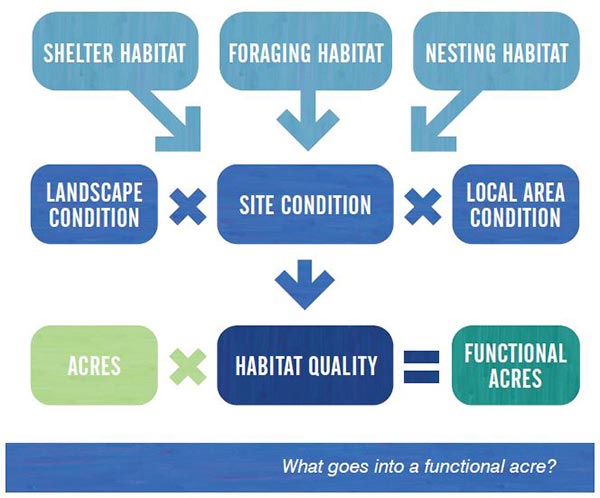Habitat Quantification Tool
A new approach that will bring greater confidence to conservation decisions

Watch our video to see how the Habitat Quantification Tool works to bring greater certainty and accountability to conservation planning for vulnerable species like the Swainson’s hawk.
Traditional conservation tools focus on acreage, but not enough on the quality of those acres. The Habitat Quantification Tool (HQT) – developed by EDF in conjunction with scientists and technical experts – uses a different approach designed to bring greater confidence to conservation decisions.
The HQT evaluates both quantity and quality of habitat using a unit called "functional acres." Habitat quality is determined using the best available science on a particular species' habitat needs. By using this tool before, during and after a conservation or development project, regulatory agencies can more precisely assess environmental impacts and generate positive outcomes for wildlife.

The functional acre calculation for greater sage-grouse measures the quality of shelter, foraging and nesting habitat, in addition to other local and landscape conditions that affect habitat quality.
Functional acres become the common language for regulators, industries, developers and landowners to base their plans on. With all stakeholders speaking the same language, conservation projects can move much more quickly. And the transparent scoring process reduces chances of litigation.
The basics
As an appraisal tool, the HQT has the flexibility to bring value and increased transparency to any conservation, restoration or mitigation project. It also serves as the basis for a habitat exchange, which rewards landowners for achieving conservation outcomes rather than following pre-defined practices.
The HQT is:
- Science-based: continually factors in the best available science – no guesswork involved
- Consistent: provides a common language – functional acres – for all parties
- Transparent: provides an objective measure of impacts and benefits everyone can understand – and tracks and reports outcomes to avoid "black box" decision making
- Comprehensive: measures quantity and quality, site- and landscape-scale habitat conditions, and direct and indirect impacts
- Scalable: can inform conservation projects from small- to large-scale efforts that cross state borders and jurisdictions
- Flexible: adjusts for changes in the landscape over time, such as climate impacts
- Efficient: using the HQT requires only the time to conduct a field-site survey and familiarity with biological assessments, Microsoft Excel, and GIS and mapping software, such as Google Earth
- Strives for net benefit: improves tracking of progress toward the goal of creating net benefit
- Achieves the highest return on investment: directs conservation dollars – both public and private – to activities and projects that provide the greatest habitat benefit
Status of the HQT
A number of Habitat Quantification Tools are currently being developed for multiple species including the monarch butterfly, greater sage-grouse and several species in the California Central Valley. The HQT has also been adapted to measure stream functions. Other species and habitats will be considered for HQT development and application in the future.











